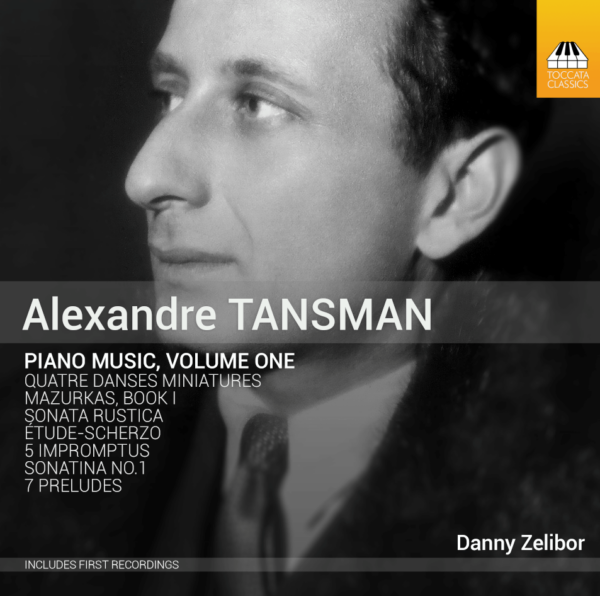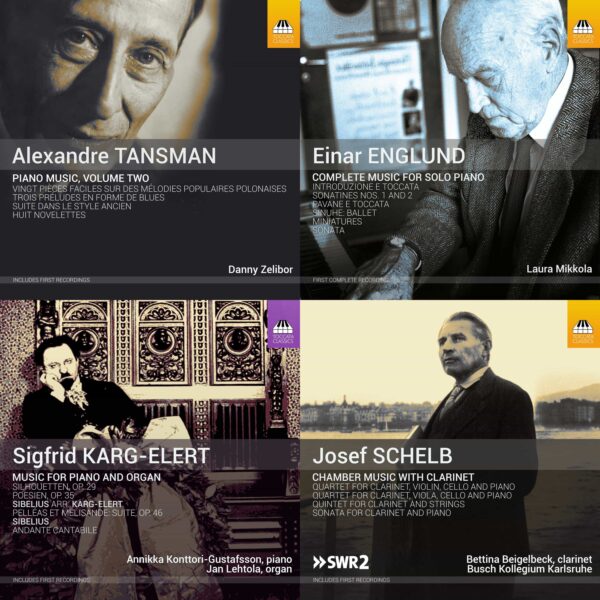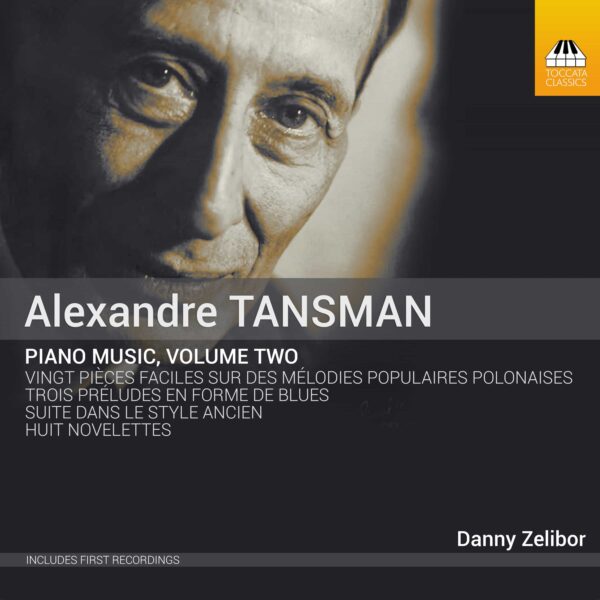Alexandre Tansman: Piano Music, Volume One
Alexandre Tansman (1897–1986) was one of the most prolific composers of the twentieth century. His fundamental style is a Stravinskyan Neo-Classicism, animated by the dance-rhythms of his native Poland and energised by a masterly command of counterpoint. The substantial body of music he produced for his own instrument, the piano, has never been systematically examined in recordings; this first installment presents works he wrote soon after his arrival in Paris in 1919, the city that was to remain his home.
Danny Zelibor, piano
Listen To This Recording:
- Sonata Rustica: I Allegro agreste – Un poco meno vivo – Piu lento – Tempo primo – Un poco meno mosso – Meno vivo
- Sonata Rustica: II Cantilena: Largo
- Sonata Rustica: III Danza festiva: Molto allegro – Un poco meno mosso – Piu vivo – Tempo primo
- 4 Danses miniatures: I Gavotte
- 4 Danses miniatures: II Menuet
- 4 Danses miniatures: III Mazurka ‘a la Chopin’
- 4 Danses miniatures: IV Petite marche
- Mazurkas: Book I: I Oberek: Vivo
- Mazurkas: Book I: II Moderato – Piu lento –Tempo primo – Moderato – Piu lento – Tempo primo
- Mazurkas: Book I: III Oberek: Molto vivo
- Mazurkas: Book I: IV Andante espressivo
- Mazurkas: Book I: V Modere
- Mazurkas: Book I: VI Moderato
- Mazurkas: Book I: VII Moderato
- Mazurkas: Book I: VIII Moderato
- Mazurkas: Book I: IX Oberek: Molto vivace – Molto meno mosso – Molto vivace
- Mazurkas: Book I: X Berceuse: Lento
- Etude-Scherzo: Molto vivace
- 7 Preludes, Vol. I: 3 Preludes: I Moderato – Lent – Tempo primo
- 7 Preludes, Vol. I: 3 Preludes: II Andantino cantabile
- 7 Preludes, Vol. I: 3 Preludes: III Moderato – Lento
- 7 Preludes, Vol. II: 4 Preludes: I Lent
- 7 Preludes, Vol. II: 4 Preludes: ii Lent
- 7 Preludes, Vol. II: 4 Preludes: iii Andante – Piu vivo – Piu lento – Piu vivo – Tempo primo
- 7 Preludes, Vol. II: 4 Preludes: IV Moderato – Un poco piu vivo
- Sonatina: I Modere – Tranquillo – Animando
- Sonatina: II In modo polonico: Allegretto – Un poco piu vivo – Tempo primo
- Sonatina: III Toccata: Vivace – Tranquillo
- 5 Impromptus: I Melodie: Andante cantabile
- 5 Impromptus: II Carillon et ronde: Allegro marciale – Piu vivo – Meno mosso – Tempo primo
- 5 Impromptus: III Berceuse: Lento
- 5 Impromptus: IV Humoresque: Molto vivace – Lento
- 5 Impromptus: V Etude: Presto – Prestissimo



Music Web International :
‘Alexandre Tansman is one of several discoveries I have made over the last two years and one I am really pleased about. … These early works show what an accomplished musician he already was, a fact underlined by his scooping the first, second and third prizes in a Polish national composition competition by the age of 22. …
He often tapped into the rich vein of Polish folk music, something that informed and enriched his natural facility for writing exceptionally good tunes. His Sonata Rustica (Piano Sonata No.1) is a perfect example of this with plenty of folk references, particularly in the third movement. …
That single-mindedness of purpose is one of the main driving forces in his pieces all of which benefit from it making them infinitely listenable. … From his Quatre Danses miniatures (here receiving their first recording) and his Mazurkas: Book I, his 7 Préludes (also a first recording) and his Sonatina (No.1) through to his 5 Impromptus (the final pieces receiving their first recording) his incredible versatility and innate ear for melody are apparent for all to hear. Listening to the sixth and eighth of his Mazurkas in particular I was struck by the similarity with Bartók in terms both of style and content inasmuch that each composer uses folk melodies in such an artful fashion. His tiny Étude-Scherzo is one of the earliest examples of Tansman’s experiments with polytonality though even then his pure ‘musicality’ prevents it from spiralling off into the realms of the untuneful. …
I’ve always been impressed by Tansman’s works and this disc proves no exception. Danny Zelibor … gives us compelling performances that will surely win over new fans for this thoroughly decent and principled human being and superlative composer. Toccata continues to shed new light on undeservedly obscure composers and deserve support and thanks from all music-lovers.’
—Steve Arloff, Music Web International, August 2015
Roberto :
Didn’t know Tansman’s compositions. I have been lucky to discover them through Danny Zelibor’s sublime interpretations. Not to be missed. Looking forward to further recordings.
Fanfare Magazine :
‘… [It is] one of the best examples of Zelibor’s playing. … the music will delight those of us who value imagination and skill in a personal but Ravel-tinged Neoclassicism, while those who feel no 20th century music is worth hearing unless it’s original should definitely look elsewhere. There are rewards here for those who stick with it, however: the mix of 19th-century sentiment and 20th-century dissonant chromaticism in the Mazurkas; the witty, furiously motoric toccatas of the Étude-Scherzo and the First Sonatina’sfinale; the Mussorgsky-like “Carillon et ronde” movement and gamelan-like textures of the chromatic Berceuse from the Five Impromptus.’
—Barry Brenesal, Fanfare Magazine Magazine, November/December 2015
Fanfare Magazine :
‘… He is not on everyone’s radar, but Danny Zelibor’s splendid new recording of his music should act as a good introduction for many. … Tansman, like so many young composers of the 1920s and 1930s with open ears, was also influenced by early American jazz. This is especially true of the third movement of his Sonatine … but even the first movement of this First Piano Sonata has as much to do with jazz rhythm as with “rustic” dances. Zelibor is absolutely spot-on in this music, capturing perfectly the balance between Tansman’s earthy syncopations and French-influenced harmonies, particularly evident in the sonata’s second movement… Overall, then, a good CD of Tansman’s music…’
—Lynn René Bayley, Fanfare Magazine Magazine, November/December 2015
Artalinna :
‘Le naturel du jeu, la plénitude du son, l’élégance de l’interprétation où tout chante sans soulignement m’ont saisit d’emblée. Le jeune homme va au cœur de cette musique secrète et splendide, parfois aussi nue que celle de Federico Mompou que Tansman affectionnait tant et dont il orchestra d’ailleurs les Scènes d’enfants.
Sans aucune crispation, respirant les vastes espaces de rêves sonores, déambulant dans cette nuit sereine où parfois s’exhalent quelques bouffées de jazz, Zelibor a tout compris de ces musiques pleines d’arrière-plans, où rodent une étrangeté heureuse qu’Alejo Carpentier avait si bien débusqué dans son article publié dans la revue Social en septembre 1929 dont le titre disait tout : « Alexandre Tansman y su obra luminosa ».
Je guetterai avec gourmandise les prochains volumes de cette aventure. ‘
—Jean-Charles Hoffelé, Artalinna